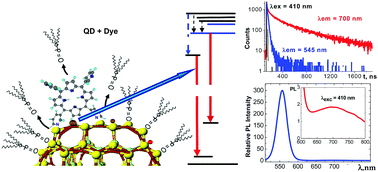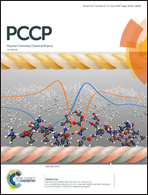The nature of non-FRET photoluminescence quenching in nanoassemblies from semiconductor quantum dots and dye molecules†
Abstract
Nanoassemblies formed via self-assembly based on colloidal CdSe quantum dots (QDs) and porphyrin (H2P) dye molecules show Fluorescence Resonant Energy Transfer (FRET) and non-FRET quenching of QD photoluminescence (PL). We present a procedure to unravel and quantify these two relaxation pathways via dynamic and static PL quenching experiments. Accordingly, FRET amounts at maximum to 10% of the total quenching efficiency. Since the degree of ligand coverage is inhomogeneously distributed across the QD ensemble PL quantum yields vary broadly. The attachment of H2P molecules occurs preferentially to those QDs with low ligand coverage. Along with that, nanoassembly formation deviates strongly from Poisson statistics. Like FRET, non-FRET depends on the QD size. We assign non-FRET quenching to the formation of specific new Cd2+ trap states following depletion of several ligands by the spacious dye molecules. While FRET follows quantitatively the Förster model, non-FRET appears on time scales of 1–3 ns in new and enhanced non-radiative near-band-edge QD PL decay channels caused by a trapping of the electrons in long-lived intra-gap states which then manifests itself in a subsequent weak PL emission. We assign the related intra-band emission to a recombination of deep-trap electrons and shallow-trap holes.



 Please wait while we load your content...
Please wait while we load your content...